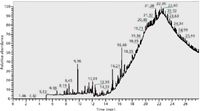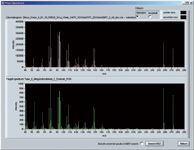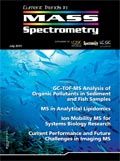High-Definition Screening for Boar Taint in Fatback Samples Using GC–MS
Special Issues
High-definition screening by gas chromatography–mass spectrometry (GC–MS) is shown to be a viable option for the reliable identification of odorous compounds in pork.
This article discusses the application of high-definition screening for the detection and identification of boar taint in fatback samples by gas chromatography–mass spectrometry (GC–MS). The application of data mining software is described and the relative merits of high-definition screening for target and nontarget compounds by GC–MS are discussed.
Boar taint is the offensive odor that can be evident during the cooking of pork or pork products derived from noncastrated pigs after they reach puberty, equivalent to a carcass weight of about 80 kg. Studies demonstrate that approximately 75% of consumers are sensitive to boar taint, with women being more sensitive than men and some ethnic groups also being more sensitive than others (1). People who are particularly sensitive to the presence of boar taint claim that the smell is very offensive, resembling urine, feces, musk, or onions. As a result, it is necessary that pork producers control boar taint.
Boar taint is caused by the accumulation of androstenone and skatole in the fatback of pigs. Androstenone is a male pheromone that is produced in the testes, and its levels increase dramatically as male pigs reach puberty. Skatole is a by-product of intestinal bacteria or a bacterial metabolite of the amino acid tryptophan and is produced in both male and female pigs. Skatole levels are much higher in intact adult male boars because testicular steroids inhibit the compound's breakdown by the liver.
Traditionally, pork producers have used castration of male piglets as the primary method of controlling boar taint. However, castration is associated with a number of limitations, including production losses due to infection, injury and herniation, reduced feed conversion compared to intact boars, and pain and stress for the animal. In some countries, such as the United Kingdom, male pigs are not castrated but are slaughtered early before reaching puberty. Nevertheless, as pig growth rates are rapid in the late finishing stage of breeding, slaughtering young animals can negatively impact the quality of pork and pork products. Another method to control boar taint is to raise only female pigs; however, this approach results in 50% less production.
Legislative Framework
European Union (EU) Regulation 854/2004 (2) mandates that meat will be declared unfit for human consumption if it exhibits organoleptic anomalies; specifically, a pronounced sexual odor. This regulation requires that the meat should be examined to identify characteristics indicating whether it presents a health risk, including odor of muscle tissue or organs. In addition, Directive 64/433/EEC (3) specifies that male carcasses weighing more than 80 kg may be allowed for human consumption provided that they bear a special mark and undergo treatment before entering the food chain. The directive further requires that carcasses must be inspected post mortem to identify any anomalies in smell.
At the same time, Directive 2008/120/EC (4) lays down minimum standards for the protection of pigs. More specifically, the directive mandates that castration of male pigs should be performed by means other than tearing of tissues. Additionally, if castration is practiced after the seventh day of life, it shall only be performed under anesthetic and additional prolonged analgesia by a veterinarian. However, as castration of piglets has raised animal welfare concerns, being viewed as a painful intervention, the EU has recently taken steps to abolish it. An agreement has been reached to stop castrating piglets without anesthesia by January 1, 2012, and a total ban has been scheduled to be implemented by 2018 at the latest (5). In Norway, piglet castration has been banned since January 1, 2009 (6).
In light of the total ban of piglet castration, an alternative method to control boar taint is necessary. Chemical analysis of meat on the slaughter line can serve as an efficient method to identify and remove tainted carcasses.
Boar Taint Detection
Presently in the EU, there is no harmonized method for detecting boar taint, but some member states are using their own testing techniques. In the United Kingdom, a hot wire test is occasionally used or a soldering iron is applied to the exposed fatback of the carcass. In Bonn, Germany, an institute has developed a reference method in which fatback is microwaved to separate the tissue from the fat; the fat is then melted and prepared for quantitative analysis. The sample is placed in a methanol extract, and incubated in an ultrasound bath at 50 °C. After this gentle heating, the solution is frozen to eliminate the fat and retain the more volatile substances for subsequent analysis. Overall, this method is particularly time-consuming as it involves extensive sample preparation.
As a result, there is a need for a more rapid technique, capable of facilitating timely detection of boar taint in the fatback of carcasses. The method must be sensitive enough to be able to identify even low levels of the compounds responsible for boar taint. Androstenone levels in fatback must lie between 500 ng/g and 1000 ng/g, whereas the maximum amount of skatole allowed is 250 ng/g.
Analytical Considerations
Traditionally, detection of target compounds by gas chromatography–mass spectrometry (GC–MS) used single-quadrupole mass analyzers. However, demand for lower detection limits has made it necessary to operate these instruments in single ion monitoring (SIM) mode. Under these conditions, full spectra are not obtained and thus selectivity and compound identification are compromised. This limitation has led to the widespread use of triple-quadrupole analyzers that, through compound-specific multiple reaction monitoring (MRM), offer selectivity and enhanced sensitivity. However, as with single-quadrupole analyzers, triple-quadrupole mass analyzers view only the specific compounds that they have been programmed to analyze. As a consequence, they are unable to detect those compounds that, while not necessarily in the target list, are still of interest.
One solution is to use high-resolution mass spectrometry (HRMS). This approach provides for absolute identification of multiple targeted and nontargeted compounds in a sample in a single run. However, the benefit of concentrating on resolution alone for improved screening of target and nontarget compounds is debatable. For instance, the inclusion of ion guides and prefilters to achieve high resolution reduces signal intensity and adds considerable cost.
As a result, although high-resolution technologies may be of overriding importance for accurate mass determination of large unknown compounds, they are not necessarily as relevant for screening target and nontarget compounds by GC against well-established libraries. Indeed, screening for targets and nontargets by GC has, until recently, been carried out successfully using single-quadrupole mass spectrometers at unit mass resolution.
That said, in the pursuit of lower detection limits, the value of high resolution in screening is to exclude matrix effects rather than elucidate structural information.
Reflecting this, interest has recently centered on a "high-definition" approach in which a high sensitivity time-of-flight (TOF)-MS system is used in a manner that delivers the benefit of matrix exclusion without compromising sensitivity. This approach also uses the inherent high data rate of TOF-MS to enable use of advanced data mining techniques for automated data processing.
Researchers at the University of Bonn (Bonn, Germany) investigated the applicability of high definition screening to the identification of boar taint in fatback samples. The aim of the research was to develop a rapid, simple, and sensitive analytical method by using a purge-and-trap approach, whereby heating of the fatback samples would no longer be necessary. The institute combined thermal desorption (TD), GC, and time-of-flight (TOF)-MS instruments to perform qualitative and quantitative analyses of odor compounds in boar fatback samples.
Experimental
TOF-MS measurements of raw data were performed on a high-definition benchtop system (BenchTOF-dx, Almsco International, Llantrisant, United Kingdom). Thermal desorption measurements were carried out using a Unity 2 thermal desorption system (Markes International Ltd, Llantrisant, United Kingdom).
The retention times of the target compounds, namely androstenone, skatole, and indole, were evaluated in conjunction with their spectral matching coefficients using a sophisticated chemometric process (TargetView software, Almsco International). The software produced a deconvolved chromatogram with high quality component spectra, extracted from the raw data. The deconvolved mass spectral data for each target compound was compared with the electron ionization (EI) mass spectra found in reference libraries.
Results
The total ion chromatogram (TIC) is shown in Figure 1. Target compounds were detected in the fatback samples at levels otherwise only achievable with quadrupole systems operating in SIM mode. Highly representative spectra obtained at these trace-level concentrations combined with deconvolution techniques delivered rapid and timely confirmation.

Figure 1: Total ion chromatogram (TIC) of raw data.
The retention times of the target compounds were determined automatically through comparison of deconvolved spectra with those in a reference library and output in a simple customizable report with details such as retention times, quantification ions, peak area values, and match coefficients, as required (see Figure 2).

Figure 2: Boar taint report generated using TargetView GCâMS data handling software.
The deconvolved mass spectral data for androstenone (retention time 18.85 min) and its relevant EI mass spectrum found in reference libraries is shown in Figure 3.

Figure 3: Deconvolved sample spectrum (top) and reference spectrum of androstenone (bottom).
Conclusion
Boar taint is the offensive odor that can occur while cooking pork or pork products and is identified in noncastrated pigs that have reached puberty. The main odorous compounds that cause boar taint are androstenone and skatole, as these accumulate in the fatback of pigs. Legislation is being introduced in the EU, declaring pork meat with boar taint unfit for human consumption. Piglet castration has long been a common practice among pork producers to control boar taint. However, animal welfare organizations have repeatedly argued against castration as it causes pain and stress to animals. In response, new legislation is expected to come into force in the EU banning piglet castration by 2018, at the latest. As a result, a need for an analytical method capable of performing accurate and rapid analysis of odorous compounds in fatback samples has been identified.
High-definition screening offers a cost-effective solution for reliable identification of odorous compounds that cause boar taint in fatback samples. Superior sensitivity is achieved without compromising speed or selectivity.
The system includes a sampling kit that allows samples to be prepared and entered into vials in the slaughterhouse, then transported to the laboratory, and processed overnight. In this way, additional time benefits are achieved and results are available within the shortest timeframe.
The new method is extremely fast, analyzing large numbers of samples within just a few minutes.
References
(1) M. Bonneau et al., Livestock Prod. Sci. 32, 63–80 (1992).
(2) Regulation (EC) No 854/2004 of the European Parliament and of the Council of 29 April 2004 laying down specific rules for the organization of official controls on products of animal origin intended for human consumption, http://eur-lex.europa.eu/LexUriServ/LexUriServ.do?uri=OJ:L:2004:139:0206:0320:EN:PDF
(3) Council Directive 64/433/EEC of 26 June 1964 on health problems affecting intracommunity trade in fresh meat, http://eur-lex.europa.eu/LexUriServ/LexUriServ.do?uri=CELEX:31964L0433:EN:HTML
(4) Council Directive 2008/120/EC of 18 December 2008 laying down minimum standards for the protection of pigs, http://eur-lex.europa.eu/LexUriServ/LexUriServ.do?uri=OJ:L:2009:047:0005:0013:EN:PDF
(5) Vetsweb.com, Total ban piglet castration in European Union by 2018, http://www.vetsweb.com/news/total-ban-piglet-castration-in-european-union-by-2018-1813.html
(6) Experience with use of local anaesthesia in piglet castration, Bente Fredriksen, Animalia, Norwegian Meat Research Centre, http://ec.europa.eu/food/animal/welfare/seminars/ab_castration_piglets_en.pdf
Torsten Haas and Peter Boeker are with the University of Bonn in Bonn, Germany.
Alun Cole and Gerhard Horner are with Almsco International, Llantrisant, United Kingdom

High-Speed Laser MS for Precise, Prep-Free Environmental Particle Tracking
April 21st 2025Scientists at Oak Ridge National Laboratory have demonstrated that a fast, laser-based mass spectrometry method—LA-ICP-TOF-MS—can accurately detect and identify airborne environmental particles, including toxic metal particles like ruthenium, without the need for complex sample preparation. The work offers a breakthrough in rapid, high-resolution analysis of environmental pollutants.
The Fundamental Role of Advanced Hyphenated Techniques in Lithium-Ion Battery Research
December 4th 2024Spectroscopy spoke with Uwe Karst, a full professor at the University of Münster in the Institute of Inorganic and Analytical Chemistry, to discuss his research on hyphenated analytical techniques in battery research.
Mass Spectrometry for Forensic Analysis: An Interview with Glen Jackson
November 27th 2024As part of “The Future of Forensic Analysis” content series, Spectroscopy sat down with Glen P. Jackson of West Virginia University to talk about the historical development of mass spectrometry in forensic analysis.
Detecting Cancer Biomarkers in Canines: An Interview with Landulfo Silveira Jr.
November 5th 2024Spectroscopy sat down with Landulfo Silveira Jr. of Universidade Anhembi Morumbi-UAM and Center for Innovation, Technology and Education-CITÉ (São Paulo, Brazil) to talk about his team’s latest research using Raman spectroscopy to detect biomarkers of cancer in canine sera.